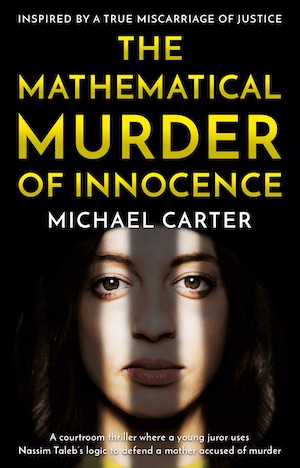
Here’s a courtroom drama that perfectly illustrates how there’s a crime thriller exactly suited to every taste, no matter how specific – even one tailor-made for a statistician accustomed to dealing with the intricacies of prediction. In some ways, you’d think that calculating odds (except, perhaps in horse racing) is a rather straightforward exercise. Yet, how you calculate them makes all the difference and the results can fly in the face of ‘common sense.’
For example, if you toss a coin that comes up heads ten times in a row, you might be inclined to take the bet that you’ll get tails on the next toss. Don’t do it! Unless the coin is faulty, each toss is an independent event and the odds of heads or tails is 50-50 every time. Likewise, you might estimate you’d need a group of at least 100 or even 200 people to find two with the same birthday. You’d be wrong. You only need 23 people to have a 50-50 chance of matching birthdates. (Google it.)
Imagine, then, the frustration of engineer Martin Fielding, protagonist in Michael Carter’s debut novel. Fielding is a juror in the trial of a woman whose two infant sons have died of cot death (crib death or Sudden Infant Death Syndrome in the US). The trial is taking place in the Old Bailey, the central criminal court for England and Wales where major cases are tried. Michael Goodwin, the prosecution’s expert witness, says that, given the relative rarity of cot death (one in every 8,500 healthy births), the odds of losing two children that way are one in 72 million (8,500 x 8,500).
Says Goodwin, a paediatrician with many years’ clinical experience and many courtroom appearances under his belt: ‘One death is a tragedy; two deaths are murder.’ But juror Fielding believes the correct odds are closer to one in 18 and sets out to prove it.
Set aside for a moment your scepticism that a juror would burst out his objections to a witness’s testimony. Or that the judge would indulge him, at all. Then set aside your doubts (perhaps they could be expressed as odds, like one in a thousand) that Fielding would be invited to take over the questioning of the expert. Once you accept the story premise – the outbursts, the cross-examination – the story becomes a delightful takedown of a pompous and dangerous man.
Goodwin is dangerous because in the novel, as in in real life, grieving mothers have been accused, convicted and imprisoned for murdering their children on exactly the faulty statistical grounds the doctor presents. There are good scenes in the jury room too, where Fielding tries to convince the mixed group of citizens wrestling with his totally foreign concepts. It’s not all uphill. He and a sympathetic female juror seem on the path to have a little fling (three to one, yes!).
A real-life case inspired Carter to write this novel. Sally Clark, who died in 2007 at age 42, was convicted of murder with the arguments Goodwin uses and, on her second appeal, exonerated by Fielding’s. But her life was destroyed. Like Sally Clark, the fictional Sarah Richardson had to deal with not only the tragedy of losing two babies, she had to endure her murder trial and vilification by the media and the public. Sarah never really comes into the drama after the death of her son George early on; she’s silent in the courtroom, her presence tangible through Fielding’s outrage.
If you really want to get into the statistics here, Carter provides several useful appendices. Given how often statistical methods are misused by public figures and the media, Carter may have done more of a public service than he anticipated. Meanwhile, he’s created an entertaining and interesting courtroom battle of wits.
Like this? Try The Holdout by Graham Moore or House of Correction by Nicci French.
The Book Guild Publishing
Print, Kindle
£2.99
CFL Rating: 4 Stars









